Discover Unmatched Comfort Aboard the Newly Renovated Letty
Set sail on the luxurious Letty, where comfort and elegance meet as you explore the Galápagos Islands. Our newly updated yacht features stunning ocean-view cabins, including 4 top-deck suites with panoramic windows and 4 lower-deck cabins with portholes, accommodating up to 16 guests for an unforgettable naturalist adventure. Families and friends will appreciate the 2 lower-deck cabins, which can be converted into triple accommodations. As an added bonus, enjoy complimentary WiFi throughout your journey . Experience the ultimate in relaxation and exploration with us.
LETTY CRUISE
NAVIGATE IN COMFORT, EXPLORE IN ELEGANCE.
LETTY CRUISE
NAVIGATE IN COMFORT, EXPLORE IN ELEGANCE.
LETTY CRUISE
NAVIGATE IN COMFORT, EXPLORE IN ELEGANCE.
ITINERARY A
ITINERARY A
7 DAYS / 6 NIGHTS
7 DAYS / 6 NIGHTS
Discover Unmatched Comfort Aboard the Newly Renovated Letty
Set sail on the luxurious Letty, where comfort and elegance meet as you explore the Galápagos Islands. Our newly updated yacht features stunning ocean-view cabins, including 4 top-deck suites with panoramic windows and 4 lower-deck cabins with portholes, accommodating up to 16 guests for an unforgettable naturalist adventure. Families and friends will appreciate the 2 lower-deck cabins, which can be converted into triple accommodations. As an added bonus, enjoy complimentary WiFi throughout your journey . Experience the ultimate in relaxation and exploration with us.
Discover Unmatched Comfort Aboard the Newly Renovated Letty
Set sail on the luxurious Letty, where comfort and elegance meet as you explore the Galápagos Islands. Our newly updated yacht features stunning ocean-view cabins, including 4 top-deck suites with panoramic windows and 4 lower-deck cabins with portholes, accommodating up to 16 guests for an unforgettable naturalist adventure. Families and friends will appreciate the 2 lower-deck cabins, which can be converted into triple accommodations. As an added bonus, enjoy complimentary WiFi throughout your journey . Experience the ultimate in relaxation and exploration with us.
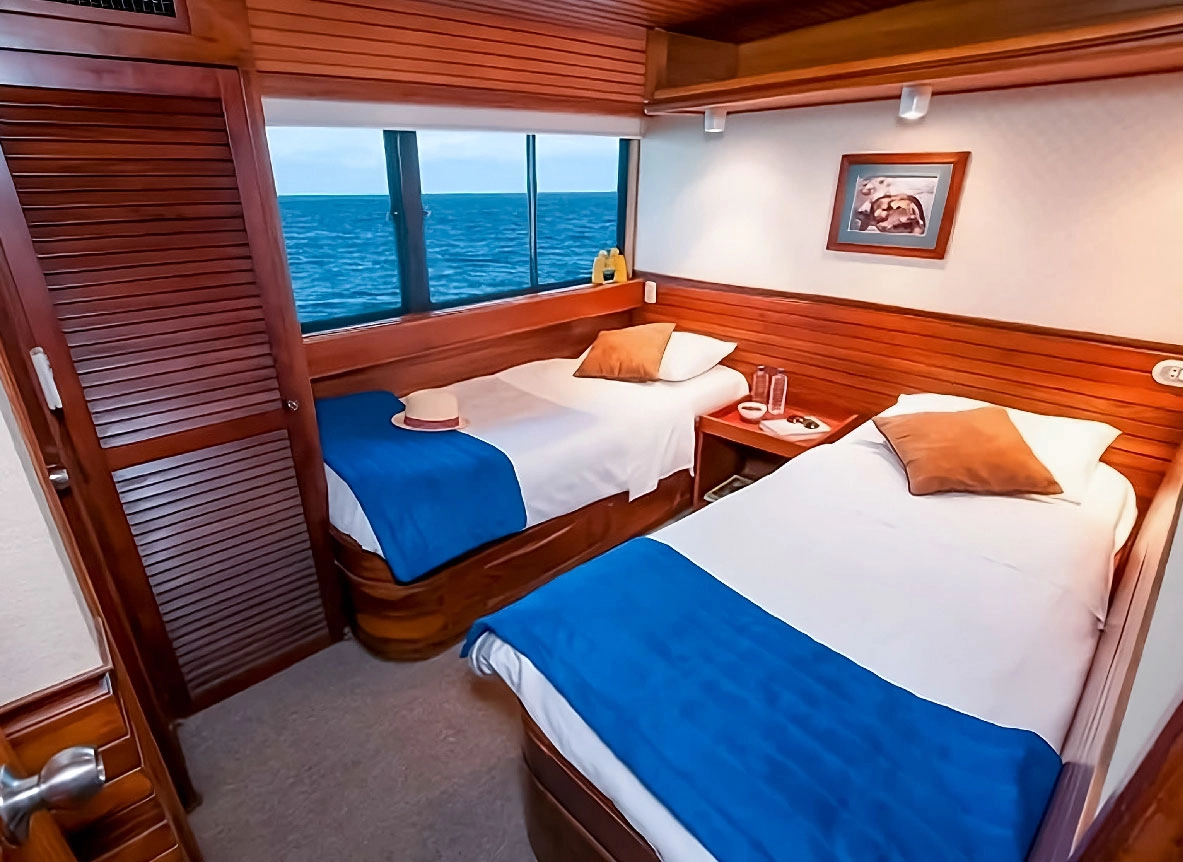
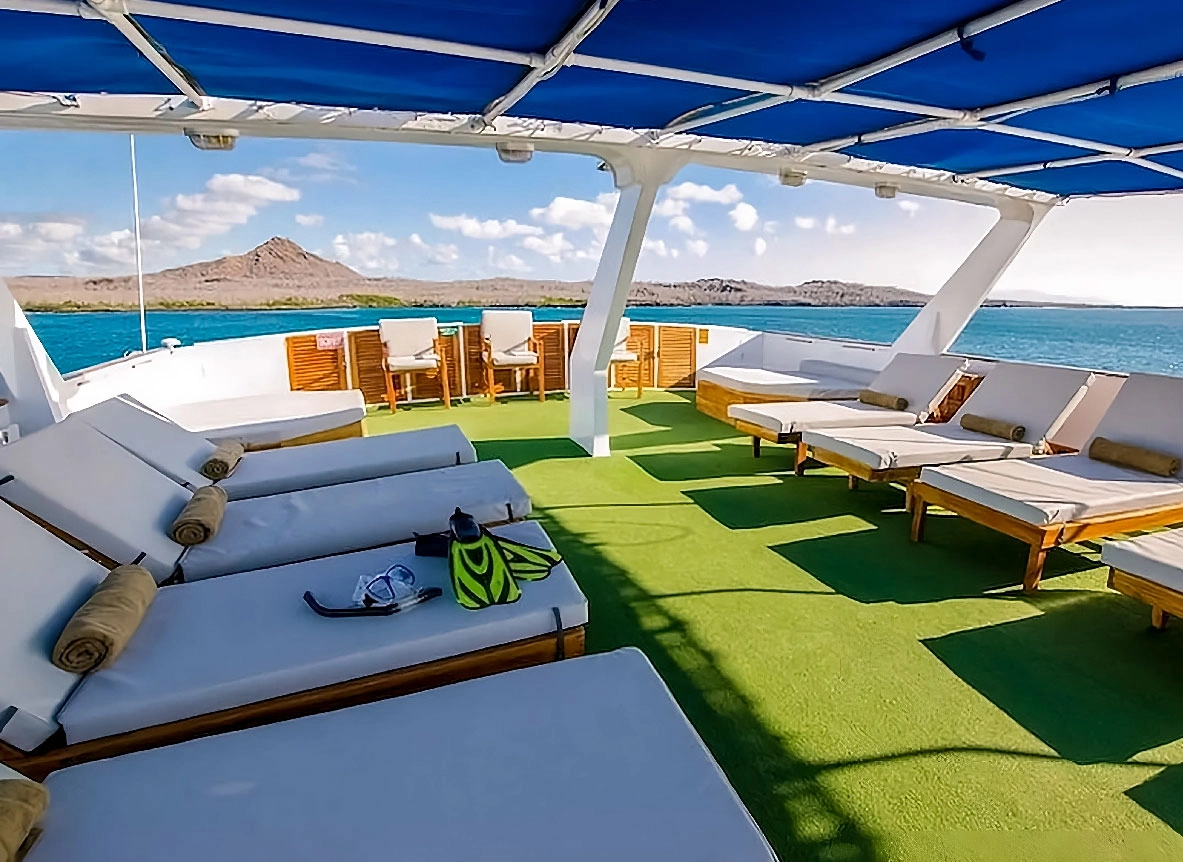
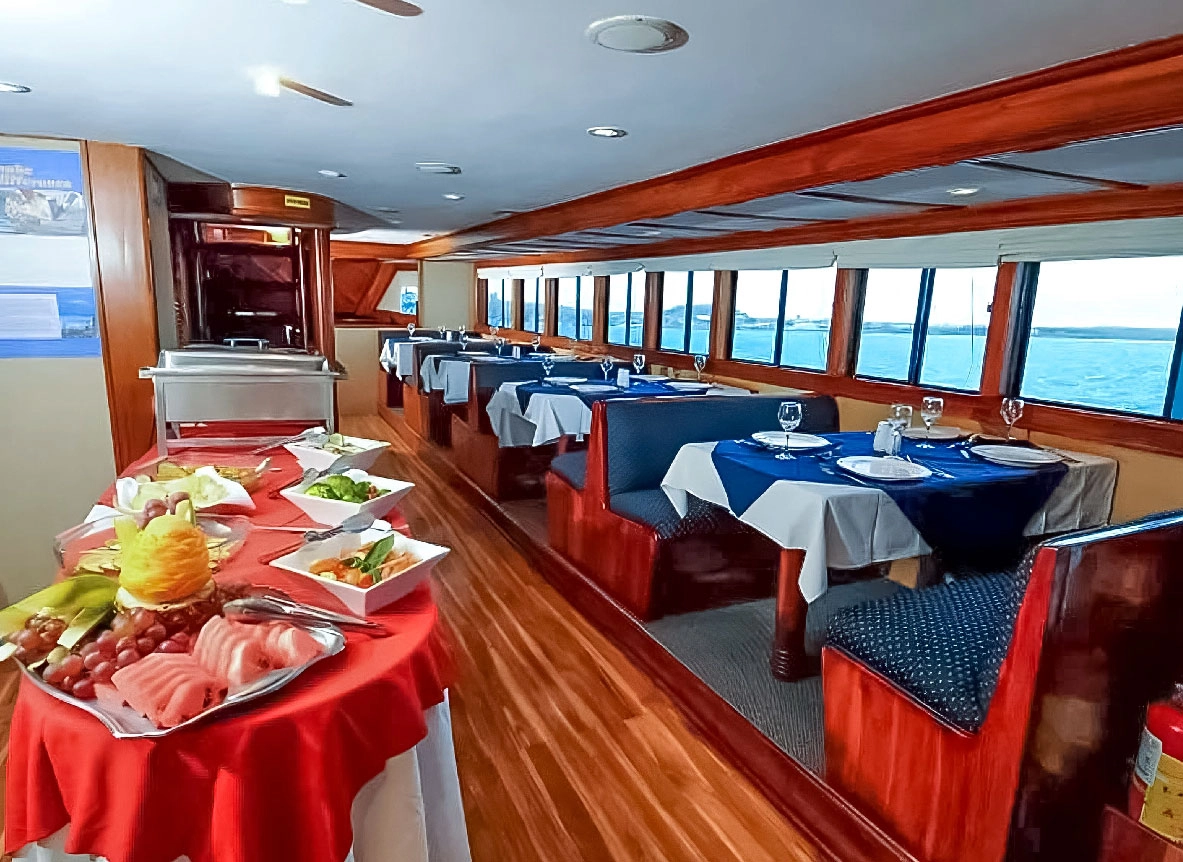
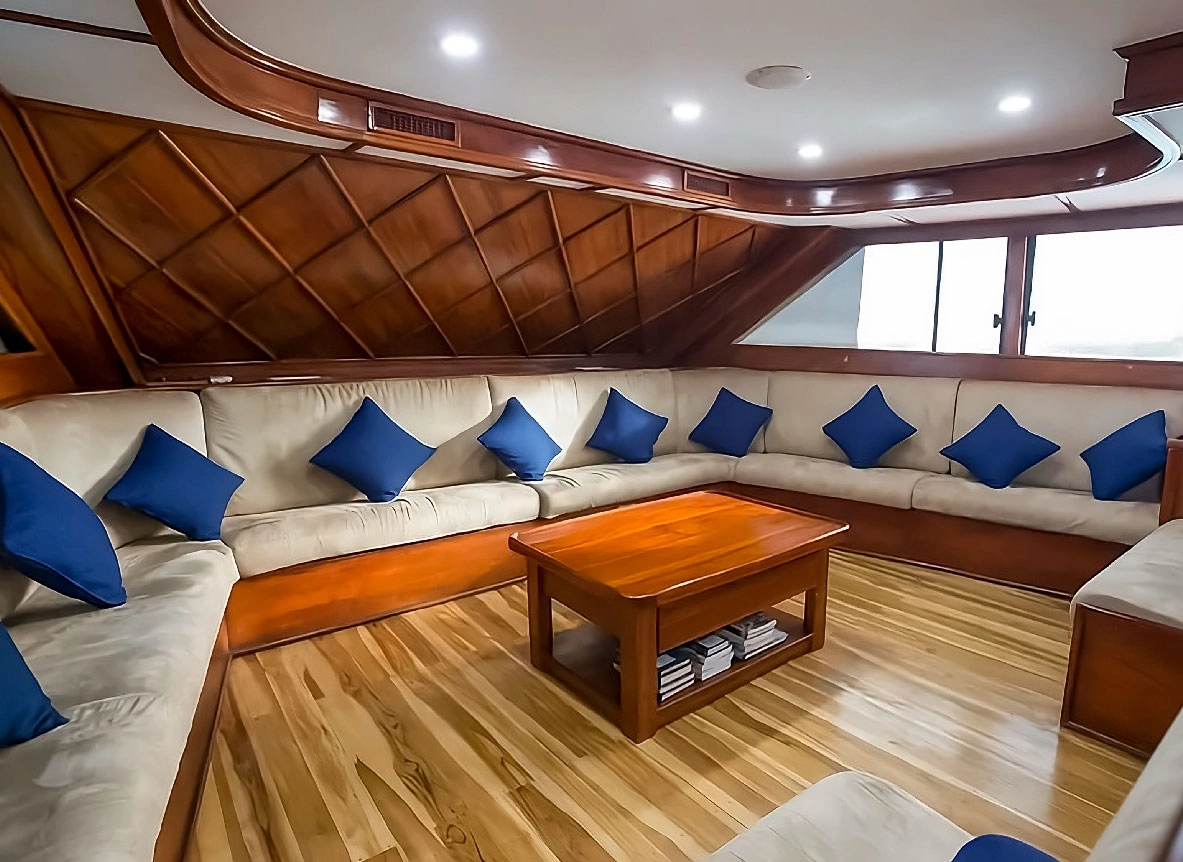
SERVICES INCLUDED ON THIS CRUISE
SERVICES INCLUDED ON THIS CRUISE
Snacks
Snacks, natural juices, soft drinks, coffee, tea and fresh drinking water.
Exclusive guides
A bilingual (English – Spanish) licensed naturalist guide for all excursions and activities during the cruise; Expert Spanish-speaking crew on board during the cruise.
Equipment
Complete snorkeling equipment: mask, fins and snorkel, wetsuits and double sea kayaks available.
Transportation
Exclusive transportation for passengers
Rooms
Accommodation in a Standard Twin/Double/Triple cabin with private bathroom and complete amenities.
Wifi
WiFi Internet service.
Eats
All meals during the cruise (from lunch on day 1 to breakfast on the last day)
Assistance
24/7 assistance in Continental Ecuador and the Galapagos Islands.
CRUISE ITINERARY
CRUISE ITINERARY
Arriving in Baltra
Galapagos Island has one of two airports that connect the islands with the
mainland. After passing immigration, visitors are taken by bus to the Itabaca Canal
pier or the cruise ships docked in Aeolian Bay.
Baltra Airport started redevelopment in 2007 to offer more eateries, stores, and a
better visitor area. Due to its dry climate, Palo Santo trees, prickly pear cactus, and
salt bushes make up Baltra vegetation. Baltra has no visitor sites. After having
lunch on board, all passengers will go to Rabida.
P..M. Rabida 14:00 – 18:00 hrs.
Wet landing on a small black-colored sand beach where sometimes it could be
difficult to disembark because of the waves on the beach. Rabida Island is a small
but striking island located in the Galapagos archipelago, off Ecuadorcoast in
South America. The island is known for its unique red-colored sand and rocks,
which are the result of the high iron content in the volcanic material that makes
up the island. Rabida is also home to several unique species, including
Galapagos penguins, sea lions, and a variety of bird species such as blue-footed
boobies and pelicans. Visitors to the island can participate in various activities,
such as hiking, snorkeling, and kayaking. These activities are to explore the
island& natural beauty and observe its diverse wildlife.
In 1954 the entire bay was uplifted 5 meters in one night by tectonic forces
and the animals that lived there, such as coral reefs, sea urchins, lobsters,
and other invertebrates were killed by the sudden uplift, which was so fast that
it even affected animals that could have walked back to the sea.
This upwelling was a block 6 kilometers long by 1 kilometer wide so that at the
end of the long trail you can see large heads of white and brain coral that before
1954 formed an interesting reef in the waters of the site.
A..M. Caleta Bucanero 08:00 – 12:00hrs.
In the morning, you will go to Caleta Bucanero. This is a picturesque
bay located on Isabela Island, in the Galapagos archipelago. The
bay is known for its crystal-clear waters and abundant marine life,
including sea turtles, rays, and colorful tropical fish. Visitors can
enjoy activities such as snorkeling and kayaking while taking in the
beautiful scenery.
P..M. Egas Port – Espumilla
In the afternoon, Puerto Egas and Espumilla are the most popular places
to have fun and end the day. These sites are located on Santiago Island.
It is known for its unique volcanic landscapes, marine iguanas, and fur
seals. Espumilla is a beautiful beach with turquoise waters, home to a
variety of bird species such as the Galapagos mockingbird and the
Darwin finch. Visitors can hike, snorkel, and swim to explore the
islands; natural beauty and observe their diverse wildlife.
A..M. Espinoza Point 08:00 – 12:00 hrs.
You will go to Punta Espinoza, which is a narrow ledge of lava and sand
extending from the volcano; base to the sea. Captain Benjamin .Morrell
recorded a Fernandina eruption in the 1820s, which led to the Point. It is famous
for its large colonies of marine iguanas and numerous other species. These
species include the flightless cormorant, Galapagos penguin, Galapagos hawk,
and Galapagos snake. Lava cactus (Brachycerus semiotics) grows on young lava
and survives on scarce water.
In the afternoon, you will enjoy Punta Espinoza. It is a narrow ledge of lava
and sand extending from the volcano; base to the sea. Captain Benjamin
.Morrell recorded a Fernandina eruption in the 1820s, which led to the Point.
It is famous for its large colonies of marine iguanas and unique species, such
as the flightless cormorant, Galapagos penguin, Galapagos hawk, and
Galapagos snake. Lava cactus (Brachycerus semiotics) grows on young lava
and survives on little water.
Isabela is a large island in the Galapagos archipelago, home to
fishing, farming, and tourism residents. It has an exceptional
vegetation zone, high elevations of the Wolf and Cerro Azul
volcanoes, and rich fauna. Conservation challenges include
the eradication of introduced species, the continued presence
of cats and rats, and the survival of the mangrove finch. Fishing
controversies have been reduced or eliminated, but sustainability
in marine ecosystems where fishing is permitted
is still a work in progress.
P..M. Urbina Bay 14:00 – 18:00 hrs.
A walk among land iguanas An impressive coral reef rises above
the surface of Urbina Bay, which is west of Isabela Island. This is the
result of a shallow sea bottom uplift in 1954. Depending on the season,
Urbina Bay is home to a variety of plant life. The colorful plants attract
many insects because of their beautiful color. A short trek inland offers
the opportunity to see giant tortoises in their natural habitat while
feeding. .Moreover, land iguanas nest in the middle of the trail, where
their yellowish skin can be observed close up. A variety of flycatchers,
Darwin;finches, and mockingbirds can be seen on the Galapagos
Islands, both on the ground and in the trees.
A..M. Elizabeth Bay 08:00 – 12:00 hrs.
On Isabela Island's western shore, in the Galapagos
archipelago, sits Elizabeth Bay, a lovely and isolated bay.
A wide diversity of marine life, such as sea turtles, rays, and
fish species, may be found in the area. Visitors may take a
boat excursion to explore the mangrove woods in the bay
and see the distinctive flora and animals of the region.
Elizabeth Bay is a must-visit location for nature enthusiasts
and those looking for a quiet retreat in the Galapagos
because of its tranquil and peaceful ambiance.
P..M. .Moreno Point 14:00 – 18:00H
On Isabela Island, on the Galapagos archipelago's southwest coast, sits
Punta .Moreno, a distinctive tourist destination. The area is well-known
for its craggy volcanic scenery and varied biodiversity, including
flamingos, sea turtles, and many bird species. Hikers can explore
the distinctive lava formations in the area and enjoy the captivating
natural beauty of this far-off island. Punta .Moreno is a well-liked resort
for nature enthusiasts and adventure seekers in the Galapagos due to
its spectacular scenery and numerous wildlife.
A..M. Tintoreras – Volcan Chico – Sierra Negra 10:00 – 12:00h
During high tide, blue sharks (white-tip sharks) cruise along the
channel or rest peacefully on the seabed rocks of a saltwater
crevice that is a favorite resting place.
Hundreds of marine iguanas nest nearby this crevice. Several
sea lion colonies live on the white mangrove beach.
There is no better place to admire the Galapagos fauna than here.
P..M. Wall of Tears – Tortoise Center 14:00 – 18:00h
The Wall of Tears: A place where brave men weep and weak men die. It is a
fascinating historical site located in Villamil, Galapagos. It is a 6-kilometer walk
from Villamil, passing the Villamil cemetery and a white-sand beach with lagoons.
It is a testament to cruelty and torture and stands 5-6 m high, 3 m wide, and 100m
long. It was built by prisoners in a penal colony from 1944 to 1959. This was a kind
of open-air prison, so the prisoners had to do forced agricultural work, as well as
build their enclosure: a wall of volcanic stones. The inhabitants say that most of the
stones came from the Sierra Negra volcano and that the wall was built without the
help of machinery but by the human strength of the captives. .Many of them died in
accidents, which is why the Wall of Tears is considered a place of mourning. After 10
years of forced labor, the prisoners rebelled and planned an escape, a deception, as
if it were the Trojan Horse. One night, the inmates presented the policemen with a
play called "The Prisoners; Escape & quot;. With homemade liquor, made by the prisoners
themselves, the guards got drunk, while they were amused by the performance. It
was then that in one of the scenes, with the double intention of making it more real,
the actors tied up the policemen stripped them of their weapons, and vandalized
the place burning it and destroying its structures completely. Panic spread to the
town of Puerto Villamil and its inhabitants hid in a church. After visiting this, we are
heading to Tortoise breeding center. We start the tour through the corrals enjoying
these unique animals in the world, where we will learn about the history of this
Centre and the history of the turtles, we also have an information room with more
interesting facts. We can return by a 30-minute walk where we will find many
endemic plants and birds such as flamingos, patios, and gallinules that live in salt
ponds. This walk takes approximately 2 hours.
A..M. Santa Cruz – Charles Darwin Center 08:00 – 12:00h
Due to its closeness to the Baltra airport to the north, Santa Cruz serves as
the primary tourism hub for the Galapagos. The interior and high heights of
a Galapagos Island can only be observed on one island. The longest paved
road in the Galapagos is on Santa Cruz; it spans the entire island from
north to south and connects Puerto Ayora, the island; largest city, situated
in Academy Bay on the southern coast, with the airport ferry at Itabaca
Canal on the island; north coast. The Galapagos National Park Directorate
(GNPD) has managed the archipelago since 1964, with CDRS working on
conservation, restoration, and sustainable development projects. In this
renowned national park site, just northeast of Puerto Ayora, over 200
scientists and volunteers are involved in research and conservation efforts,
the most well-known of which involves giant tortoise captive breeding
programs. Through the arid zone vegetation, you can observe Galapagos
giant tortoises in their enclosures. A nursery with incubators is also
available (the baby tortoises are repatriated to their home islands once
they reach 1.5kg or about four years old).
P..M. Tortuga Bay 14:00 – 18:00h
From Puerto Ayora; main street, Tortuga Bay can be reached in about an
hour. Land birds may be spotted along the trail, which travels through
arid areas. Once reaching the coast, there are two beaches; only strong
swimmers should join the long beach open to the ocean due to its
powerful undercurrents. Tortuga Bay; second beach lies to the north.
The water is calm there. Activities:
San Cristobal is the fifth-largest and easternmost island of the Galapagos,
home to the oldest permanent settlement, and where Darwin first stepped
ashore in 1835. Manuel Cobos and Jose .Monroy formed the Orchillera
Company, a penal colony; sugar cane plantations were established; and a
fishing company flourished from 1952 to 1960. Puerto Baquerizo .Moreno is
the capital of the Galapagos province.
Isla Lobos – Return to the mainland
From San Cristobal, it takes a boat one hour to reach this islet. Although it has
been designated for the colony of sea lions that occasionally inhabit the area, it
is a seasonal nesting spot for blue-footed boobies. There are occasionally fur
seals as well. There have also been several frigatebird
nests there. The islet is a wonderful location for snorkeling and offers a
serene, picturesque environment.
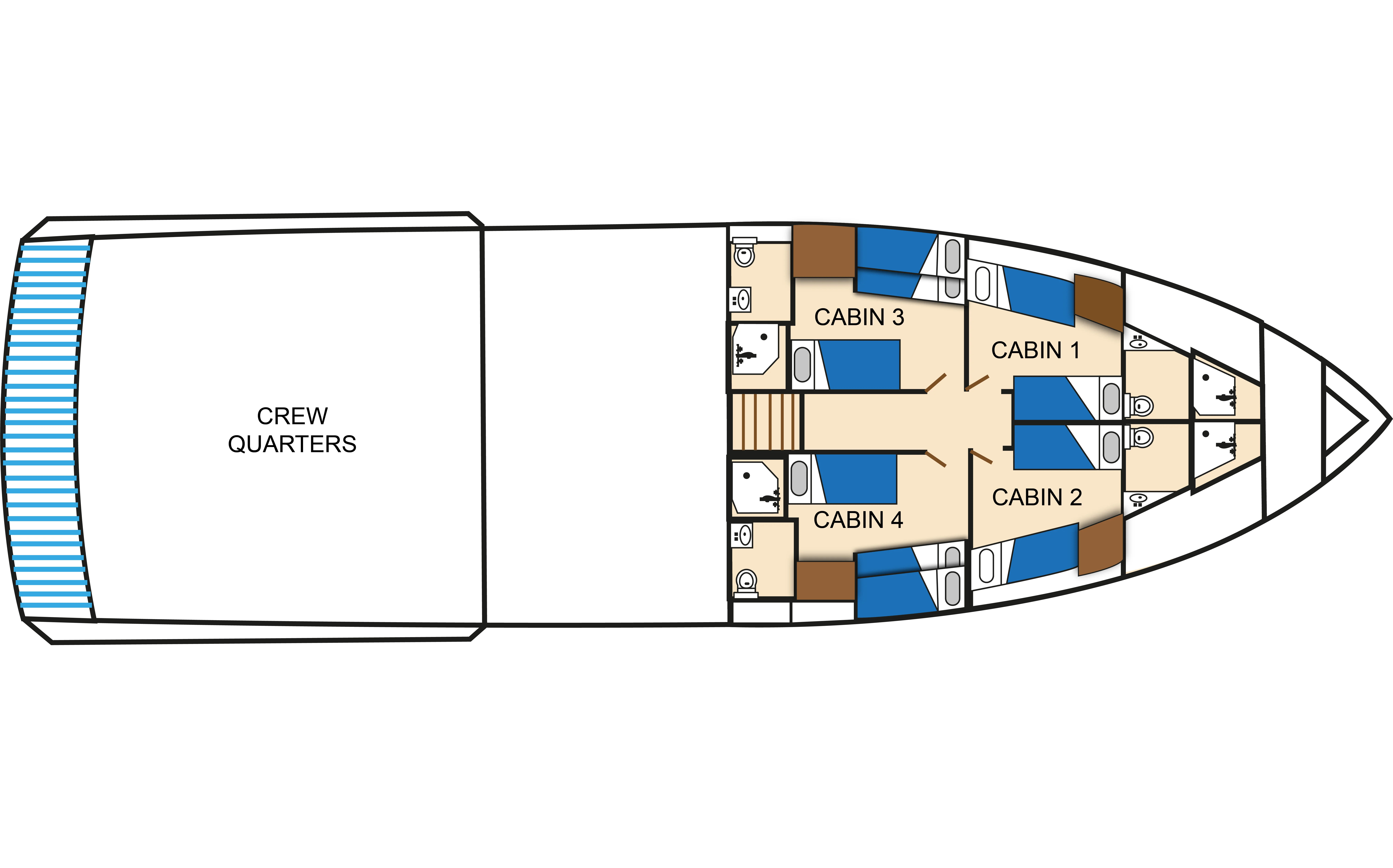
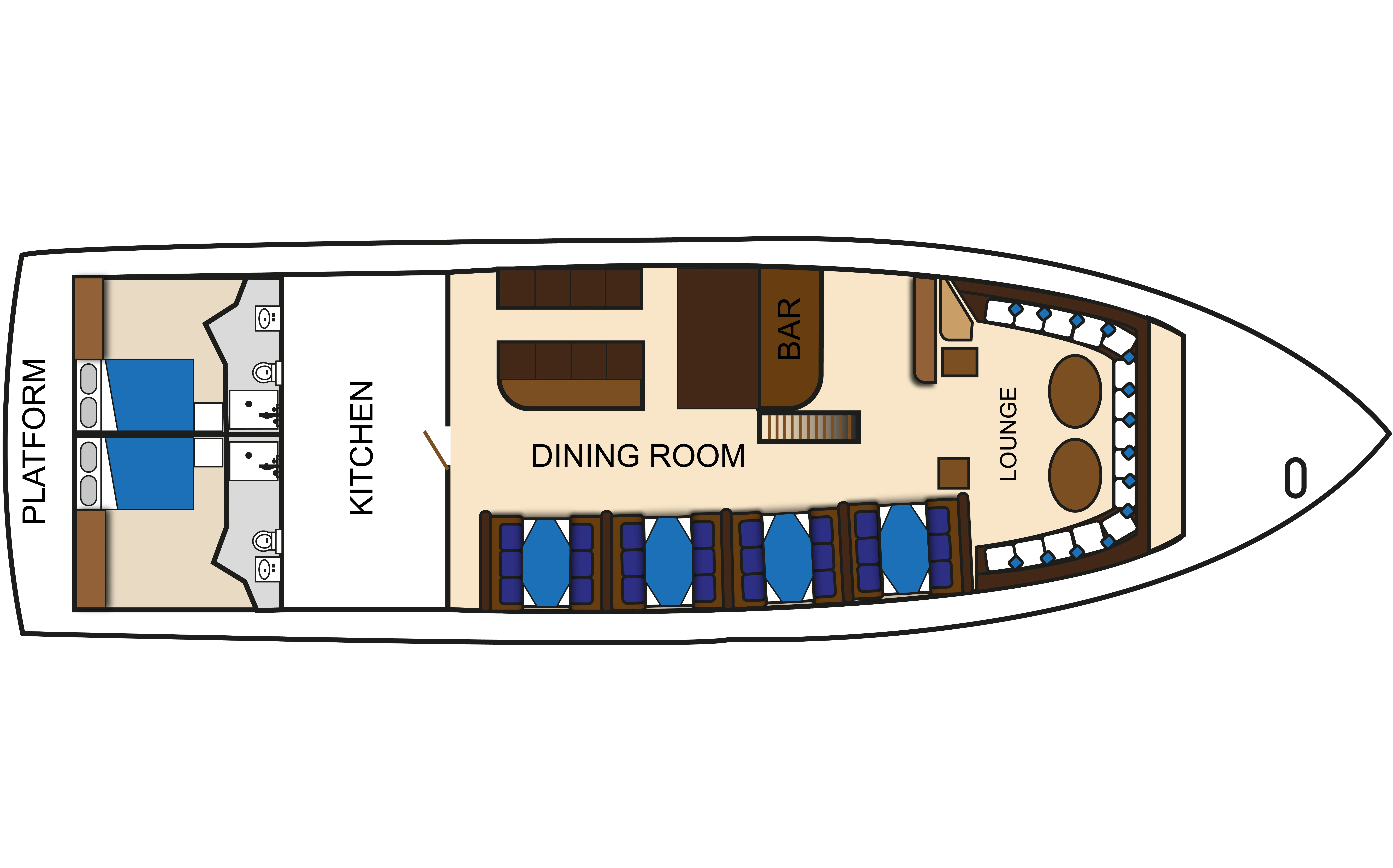
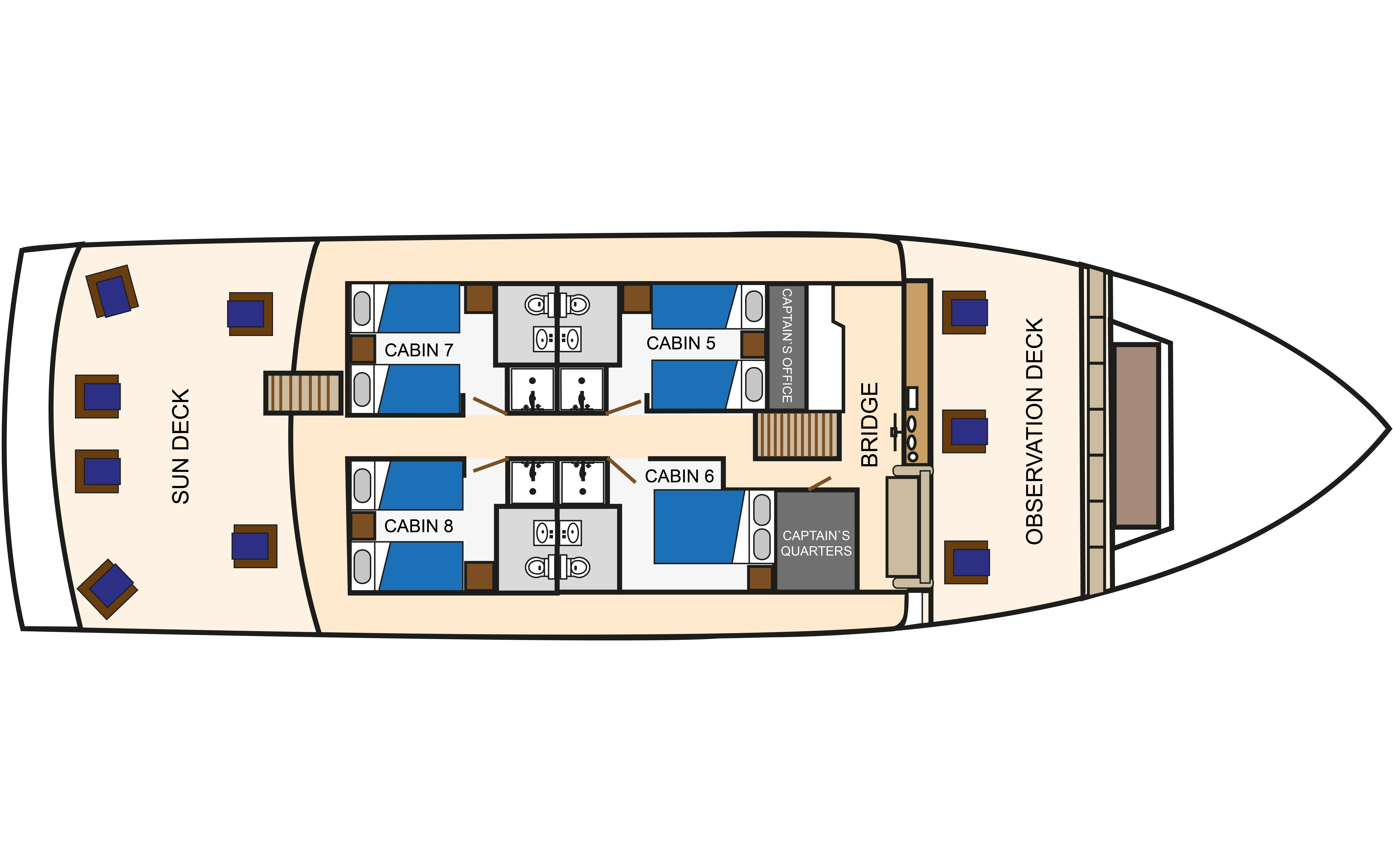
LOWER DECK
7 DAYS / 6 NIGHTS-
FOR PERSON
-
DOUBLE ROOM
UPPER DECK
7 DAYS / 6 NIGHTS-
FOR PERSON
-
DOUBLE ROOM
LOWER DECK
7 DAYS / 6 NIGHTS-
FOR PERSON
-
TRIPLE ROOM
RESERVE NOW
Discover our other amazing cruise options and set sail on a journey like no other! Whether you’re dreaming of exotic destinations, luxurious amenities, or unforgettable experiences, we have the perfect cruise for you in Galapagos.
Flight tickets to & from Galapagos from/to Quito or Guayaquil: USS 495.00 per adult (rate for Children between 6 & 11 years-old upon request).
Mandatory Galapagos National Park Entrance Fee (in cash upon arrival to Islands): US$200 per adult & US$100 per child (between 6 & 11 years-old); mandatory Migratory Control Card (in cash at Airport before Check-In in Quito or Guayaquil): US$20 per adult and/or child.
Personal expenses, extras, alcoholic drinks and other items of personal inature.
Tips for Guide and Crew: recommended USA 15 in cash per person per day for Guide and USS 15 in cash per person per day for the entire Crew.
Travel and personal Insurance: We highly recommend for guests to purchase insurance that covers: trip cancellation, international flight delay/cancelation, trip interruption, medical coverage and baggage loss/damage coverage.
All Itineraries are unlikely to change significantly but are susceptible to changes due to: Weather, wildlife breeding, safety concerns, instructions from the Galapagos National Park, specific abilities and interests of passengers as well as operational matters that may cause your guide or the yacht‘s captain to change timings of certain visits. Your guide and captain will always endeavor to select the best itinerary within these limits.
